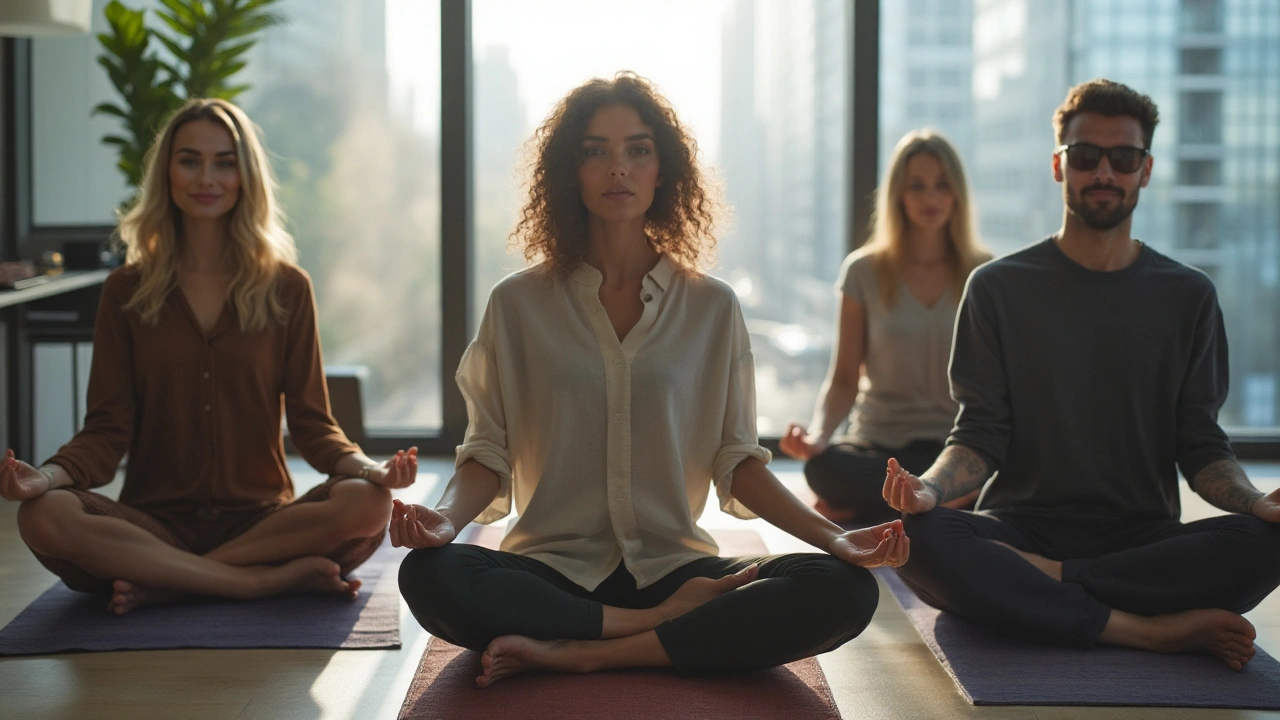In the hustle and bustle of modern life, stress often feels like an inevitable companion. But what if you could turn this familiar foe into a source of strength? The good news is, you can. Science and experience show us that managing stress effectively not only improves mental health but also boosts our capacity to achieve and enjoy more in life.
By exploring and embracing a variety of stress reduction techniques, you have the power to make significant changes. Whether through mindfulness, physical activity, or personalized plans, each method offers unique benefits that contribute to a more balanced and fulfilling life. Let's embark on this journey together, unlocking the potential that lies within each of us.
- Understanding Stress and Its Effects
- The Science Behind Stress Reduction
- Practical Relaxation Techniques
- Mindfulness and Meditation Practices
- Physical Activities to Manage Stress
- Creating a Personal Stress Reduction Plan
Understanding Stress and Its Effects
Stress is a universal experience, a complex web of physical and emotional responses triggered by the demands we face. Imagine stepping on a scale that tips back and forth—it reflects the balance we strive to maintain amidst life's pressures. Our bodies are ingeniously designed to handle stress in short bursts. This is evident in the 'fight or flight' response, a survival mechanism that floods your system with hormones like cortisol and adrenaline. These give you a burst of energy, sharpen your focus, and prepare you to tackle challenges head-on. However, when stress becomes chronic and lingers, it can have significant repercussions on our health and well-being.
When stress becomes a regular part of life, it starts to impact the body in negative ways. Chronic stress is linked to numerous health issues, ranging from heart disease and obesity to mental health disorders like anxiety and depression. The constant surge of stress hormones can wear down the body's systems, leading to fatigue and diminished immune function. Interestingly, your brain also takes a hit. Persistently high levels of cortisol can affect memory and learning, stunting your cognitive growth. It's crucial to acknowledge these effects, as understanding them is the first step in mitigating stress's grip on your life.
Our society often glorifies busyness, overlooking the devastating impacts prolonged stress can have. With the advent of technology, our earth has shrunk into a global village, accessible at the click of a button, but this has also blurred the boundary between work and personal life, contributing to mounting stress levels. According to a study published by the American Psychological Association, more than 75% of adults report experiencing physical or emotional symptoms of stress. This statistic alone highlights the necessity for effective stress management strategies in our daily routines.
Recognizing the signs of stress is essential. They vary from person to person, but common symptoms include irritability, insomnia, loss of appetite, or even physical symptoms like headaches and stomach issues. It's important to identify your personal stress triggers and responses. By keeping a stress journal, you can track patterns and learn to anticipate situations that typically cause stress. This proactive approach empowers you to take control before stress escalates, paving the way for targeted stress reduction techniques tailored to your personal needs.
Hans Selye, known as the father of stress research, once said, "It’s not stress that kills us, it is our reaction to it." His words remind us that while we may not choose our stressors, our response is within our control. Understanding and mastering that response is the key to unlocking our potential and leading a more balanced life.Identifying stress as neither inherently good nor bad, but rather as a signal or alarm, offers an enlightening perspective. It calls us to action; to make changes either externally in our environment or internally in our perception. By adopting an active role in managing stress, we reclaim our quality of life, enhancing resilience and fostering a more optimistic outlook on future challenges.
The Science Behind Stress Reduction
Diving into the science of stress reduction is not just an exploration of the mind, but of the body's profound response mechanisms as well. Stress originally evolved as a survival mechanism called the fight-or-flight response. When we perceive a threat, our body triggers a significant release of hormones, such as cortisol and adrenaline. These hormones prepare us to react quickly by increasing heart rate, redirecting blood to essential muscles, and enhancing brain alertness. While advantageous in life-threatening scenarios, these responses can become damaging if persistently active during daily life challenges. Chronic stress leads to issues like hypertension, weak immune response, anxiety, and insomnia, emphasizing the need for effective management strategies.
A pivotal component of stress reduction lies in the way our nervous system can learn to moderate the stress response. Research indicates that practices such as mindfulness and meditation stimulate the parasympathetic nervous system, allowing the body to enter a restorative state, often called "rest and digest." This process not only calms the mind but also contributes to several physiological benefits, including reduced blood pressure and a slower pulse rate. Studies conducted by neuroscience experts highlight how consistent mindfulness practices can alter parts of the brain associated with emotional regulation and self-control. In numerous documented cases, participants who engaged in eight-week mindfulness courses displayed increased gray matter density in the hippocampus, which is critical for learning and memory. These changes suggest the brain's remarkable adaptability and the potential long-term benefits of stress reduction techniques.
Incorporating stress reduction practices into daily life can yield profound effects on physical health. For instance, restorative yoga and tai chi are gentle forms of exercise that have been shown to significantly improve stress biomarkers. According to a compilation of studies, individuals practicing these activities regularly observed not only decreased stress levels but also enhancements in flexibility, balance, and overall quality of life. A focus on controlled breathing is central to these practices, promoting relaxation and a heightened awareness of how different muscles react to stress. Breathing techniques, such as diaphragmatic breathing, activate the vagus nerve, further supporting the parasympathetic response.
Understanding stress reduction through a scientific lens instills confidence in its efficacy. As Dr. Herbert Benson of the Mind/Body Medical Institute observed, "The mind has the power to help heal the body by engaging our inherent stress-reduction processes." This insight underscores the interconnectedness of mental and physical health, reinforcing why adopting stress-reducing habits is essential. Whether you're a seasoned practitioner or just beginning your journey, the science behind these mechanisms provides a credible foundation that advocates for incorporating such techniques into everyday life. By recognizing how they directly impact biological processes, the choice to practice stress reduction becomes not just a lifestyle modification but a critical component of self-care and personal growth.

Practical Relaxation Techniques
Relaxation techniques are like magic keys that unlock the door to serenity, allowing us to navigate through life's challenges with a calm heart and clear mind. In our quest to reduce stress, it's vital to find strategies that resonate with our individual lifestyles and personalities. Breathing exercises, for instance, have been celebrated for centuries for their ability to anchor the mind and slow down the heartbeat. By focusing on your breath, taking deep and even breaths in through the nose and out through the mouth, you induce a state of relaxation that can steady a racing mind. Discovering the rhythm of your breath can offer immediate relief from anxiety and tension.
Visualization, also known as guided imagery, is another powerful technique. When life feels overwhelming, closing your eyes and picturing a peaceful scene can transport your mind away from stress. Imagine yourself walking along a serene beach, feeling the soft sand under your feet and listening to the gentle waves. Such mental escapes can provide temporary relief and can even be practiced at your desk or during a quick break. They enable you to reset your mental state, preparing you to tackle your tasks with renewed vigor.
Progressive muscle relaxation is an effective method that involves tensing and then slowly releasing different muscle groups. This technique encourages awareness of physical sensations and teaches the body to recognize and combat tension. Start with your toes, slowly moving upwards, allowing the tension to ebb away with each breath. As you release the physical stress, mental stress often fades with it, leaving you feeling both relaxed and invigorated.
For those seeking a more dynamic approach to stress reduction, yoga combines mindfulness with physical activity, enhancing the connection between body and mind. Studies have shown that regular practice of yoga can decrease stress hormones in the body while simultaneously increasing the production of endorphins, the body’s natural mood elevators. Whether you are a beginner or seasoned practitioner, the deliberate postures and breathing techniques practiced in yoga can significantly bolster your battle against stress.
Listening to music is another simple, yet profound relaxation tool. It's well-known that music has the ability to alter our mood, tapping into emotions with just a few notes. Choose melodies that calm and soothe, perhaps classical or nature-inspired tunes, to create an auditory oasis amidst a turbulent day. Let the gentle harmonies wash over you, easing tension and encouraging a peaceful frame of mind.
"The greatest weapon against stress is our ability to choose one thought over another." — William James
Lastly, journaling offers a reflective practice that allows for emotional release. Writing about your thoughts and feelings can help clarify and organize them, guiding you to understand stress triggers and coping mechanisms. Try starting or ending your day with a few minutes of writing, focusing on gratitude or introspection. By transferring your worries onto the page, you can gain perspective and pave the way to a more stress-free life. Whatever technique you choose, consistency is key, as regular practice can lead to long-term benefits, enhancing your mental health and productivity.
Mindfulness and Meditation Practices
Amid the daily chaos, mindfulness and meditation emerge as powerful allies in stress reduction and mental well-being. These ancient practices, rooted in various cultures, have been adapted and researched extensively to suit our modern lifestyles. At its core, mindfulness invites us to focus our awareness on the present moment, cultivating an attitude of openness and acceptance. The practice hones our attention, allowing us to experience life's moments with clarity and purpose, reducing the chatter of stress-induced thoughts.
Research conducted over the years highlights the significant benefits of regular meditation. It aids in decreasing anxiety, enhancing concentration, and fostering emotional health. Remarkably, studies show that consistent practice can even remodel the brain, increasing grey matter in areas responsible for memory and emotional regulation. This underscores how pivotal these practices can be in our quest for mental harmony. Imagine starting your day with a few minutes of meditation, gradually witnessing a shift in how you react to challenges.
"Mindfulness isn't difficult, we just need to remember to do it," says Sharon Salzberg, a renowned mindfulness teacher and author.
Delving deeper, there are varied techniques within meditation itself, each catering to different needs. From Transcendental Meditation, which involves repeating a mantra, to Mindfulness-Based Stress Reduction (MBSR) designed by Dr. Jon Kabat-Zinn, there's something for everyone. Perhaps you prefer guided imagery meditation, where a teacher or recording guides you through peaceful scenes, engaging all sensory experiences. By exploring different methods, you’ll find what resonates most with you. Integrating these practices into daily life need not be a challenge but rather a rewarding experience.
To start, consider these simple steps to build a meditation routine:
- Designate a quiet, comfortable space where distractions are minimal.
- Set a timer, starting with just five minutes, gradually increasing as you become comfortable.
- Focus on your breathing, acknowledging thoughts when they arise and gently returning to the breath.
- Consider using meditation apps, which offer a plethora of options tailored to beginners and advanced practitioners alike.
While embracing meditation, it's crucial to remember patience with oneself. The journey towards mastering mindfulness is ongoing, yet rewarding. As you integrate these peaceful moments into your life, observe the subtle transformations in your interactions and perceptions. This practice is not about immediate results, but rather consistent effort towards inner tranquility.

Physical Activities to Manage Stress
Engaging in physical activities is one of the most effective ways to combat stress. Exercise not only improves your physical health but also has numerous mental health benefits. When you get moving, your body produces endorphins, commonly known as the ‘feel-good’ hormones. These chemicals act as natural painkillers and can elevate your mood. Regular involvement in physical activities can significantly lower the symptoms of stress while enhancing your overall mood.
Exercise doesn't have to mean hitting the gym or lifting weights. It can be anything that gets you moving and your heart pumping. Consider taking a brisk walk through a park, enjoying the beauty of nature. In Adelaide, for instance, the stunning landscapes offer a refreshing backdrop to unwind and reduce stress levels. A leisurely bike ride along the River Torrens Linear Park Trail can be a perfect way to soak in some sun and serenity.
Yoga, a practice dating back thousands of years, combines physical poses, breath control, and meditation. It is particularly effective in reducing stress. By focusing on slow, deliberate movements and deep breathing, yoga aids in relaxing the mind and easing tension in the body. Studies show that yoga practices lower cortisol levels, the hormone associated with stress. Attending a local class or following online tutorials can easily incorporate this into your routine.
"Exercise is a celebration of what your body can do. Not a punishment for what you ate.” — Anonymous
For those who enjoy structured workouts, joining a dance class could be an exhilarating option. Dance isn't just a good cardiovascular workout; it's also a fantastic way to express yourself and de-stress. Whether it's salsa, hip-hop, or jazz, the combination of music and movement can transport you to a happier mental state.
Don't underestimate the power of team sports. Playing soccer, basketball, or even joining a Sunday league can provide not only physical benefits but also a sense of camaraderie and community. Engaging in these sports offers a dual advantage: you get to exercise while nurturing social connections, which can further alleviate stress.
Creating an Effective Exercise Routine
If you're starting from scratch, having a planned exercise routine can help maintain consistency, which is crucial to reaping the stress-reducing benefits. Here’s a simple approach to get you started:
- Identify activities that you enjoy or are curious about trying.
- Set realistic goals for frequency and duration. Aim for at least 150 minutes of moderate aerobic activity weekly.
- Pencil these activities into your weekly schedule as non-negotiable appointments.
- Listen to your body. Rest when necessary, but try to avoid long lapses in activity.
- Monitor your progress, and adjust your routine as needed to keep it challenging and engaging.
Regular physical activities not only manage stress but boost self-confidence and improve sleep. By forming a balanced routine, tailored to your preferences and lifestyle, the benefits can be life-changing. Everyone's body and mind react differently, so experiment with various activities to discover what works best for you. This journey is as much about the exploration as it is about the destination.
Creating a Personal Stress Reduction Plan
Embarking on the journey to reduce stress through a personalized plan can feel a bit overwhelming at first, but it's essential for living a balanced and productive life. The first step involves identifying the key stressors in your daily routine. These could range from work pressures, financial worries, to relationship dynamics and even health concerns. Once you've pinpointed these triggers, assess how they make you feel physically and emotionally. Recognizing these responses can help you devise a more effective strategy tailored to your unique experiences and circumstances.
Developing your plan requires an understanding of stress reduction techniques that resonate with you. Mindfulness practices, such as meditation and breathing exercises, provide excellent starting points, offering simple ways to center your thoughts and calm your mind. Tailor these exercises to fit into small pauses throughout your day, like during a lunch break or while decompressing at day's end. Simultaneously, consider how physical activities might liberate you from stress. Exercise doesn't need to be intense to be effective; even a regular brisk walk can do wonders for clearing your mind and releasing tension. Incorporate activities that you genuinely enjoy, as this increases the likelihood of maintaining them over time.
Equally crucial is the integration of healthy lifestyle habits into your routine. Commit to a balanced diet, adequate sleep, and regular hydration, all of which can help stabilize your energy levels and mood, reducing stress. Reflect frequently on your plan's effectiveness, making adjustments as necessary. Writing down these reflections can be enlightening, highlighting patterns or progress you might overlook. Developing practical skills, such as assertiveness in communications and efficient time management, is also invaluable in preventing stressors from escalating in the first place, thus proving pivotal in your plan's success.
"Adopting the right attitude can convert a negative stress into a positive one." - Hans Selye
Setting Realistic Goals
When crafting your stress reduction plan, setting realistic and achievable goals is vital. Break down your objectives into manageable steps, fostering a sense of accomplishment with each milestone reached. For instance, if reducing work-related stress is your aim, allocate time specifically for focused tasks, creating limits around your potential stress triggers. You might employ techniques like the Pomodoro Technique, which encourages working in bursts of focused activity followed by short breaks. Visualization techniques can also support emotional readiness for stressful situations, allowing you to practice and hone your responses.
Remember, building a personal stress reduction plan isn't about eliminating stress entirely; it's about learning to manage and harness it so you can thrive. Balance, flexibility, and patience are key components in developing a plan that evolves alongside you, responding to new challenges and growth. By consistently applying these strategies and re-evaluating your approach as needed, you'll foster resilience and well-being, ultimately empowering yourself to live a more rewarding life.

